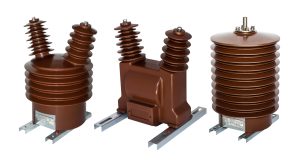Advanced Applications of Nanocrystalline Cores in Instrument Transformers: A Detailed Review
Introduction
In the rapidly evolving landscape of electrical engineering, the materials used in constructing core components like transformers are pivotal in defining the efficiency, accuracy, and reliability of power systems. Among these materials, nanocrystalline cores have emerged as a revolutionary solution, particularly in the design and functionality of instrument transformers. This article delves into the role of nanocrystalline cores, offering a detailed exploration of their properties, benefits, and applications within this critical area.
The Role of Instrument Transformers
Instrument transformers are specialized devices integral to the monitoring and control of power systems. They are primarily used to measure electrical quantities such as voltage and current, ensuring that data is accurately relayed for metering systems, protection equipment, and in power quality monitoring. Instrument transformers achieve this by safely isolating measurement circuits from the high voltages or currents typically present in the power system and scaling down these electrical quantities to manageable levels. The two main types of instrument transformers are Current Transformers (CTs) and Potential Transformers (PTs), each serving a unique function in power system operations.
Importance of Core Material
The heart of any instrument transformer is its magnetic core, which significantly influences its performance. The core’s material affects the transformer’s ability to accurately and efficiently process electrical signals. Traditionally, cores have been made from materials like silicon steel or ferrite, but these materials often pose limitations in terms of saturation magnetization, core losses, and operational frequency range. In contrast, nanocrystalline cores offer superior properties, including higher permeability, lower losses, and excellent temperature stability, which translate into enhanced performance in instrument transformers.
Understanding Nanocrystalline Cores
Definition and Composition
Nanocrystalline materials are made from an alloy predominantly composed of iron (Fe) combined with small additions of silicon (Si), boron (B), and sometimes other elements like copper (Cu) and niobium (Nb). The term “nanocrystalline” refers to the ultra-fine grain structure of these materials, with grain sizes typically in the range of 10 to 20 nanometers. This is significantly smaller than those found in conventional silicon steel cores, which can be upwards of several millimeters in grain size.
Manufacturing Process
The production of nanocrystalline cores involves a sophisticated metallurgical process known as rapid solidification or melt spinning. This technique cools down the molten alloy at a rate of about one million degrees Celsius per second, resulting in an amorphous or non-crystalline structure. The material is then subjected to a controlled heat treatment (annealing) process, which partially crystallizes the material, forming the nanoscale grain structure that imparts unique magnetic properties to the core.
Key Properties of Nanocrystalline Cores
- High Permeability: Nanocrystalline cores exhibit extremely high magnetic permeability, which allows them to achieve a high level of magnetic flux with lower magnetizing force. This property is critical for reducing the size of the core while maintaining performance in instrument transformers.
- High Saturation Magnetization: These cores can handle a high level of magnetic flux before saturating. This characteristic is vital for applications involving high currents or voltages, enabling instrument transformers to operate efficiently under these conditions without loss of accuracy.
- Low Core Losses: Nanocrystalline cores are particularly advantageous in applications requiring high-frequency operation due to their very low power losses at high frequencies. This efficiency is crucial for reducing energy waste and heat generation in power systems.
- Improved Temperature Stability: Unlike many traditional materials, nanocrystalline cores maintain their performance characteristics across a wide range of temperatures, making them suitable for various climatic conditions without degradation of their properties.
Comparison with Other Core Materials
When compared to traditional core materials such as silicon steel and ferrite, nanocrystalline cores offer a blend of high saturation magnetization and low coercivity, which are not typically found together in one material. While silicon steel is known for its cost-effectiveness and good saturation flux density, it falls short in high-frequency applications due to higher core losses. Ferrites, on the other hand, offer good high-frequency performance but cannot handle high flux densities and are more brittle.
Nanocrystalline cores address many of these limitations, providing a robust, high-performance alternative that meets the demanding requirements of modern electrical applications. This balance of properties makes them an increasingly popular choice for instrument transformers, where precision and efficiency are paramount.
Advantages of Nanocrystalline Cores in Instrument Transformers
Enhanced Measurement Accuracy
- High Permeability and Low Coercivity: The extraordinary high permeability of nanocrystalline cores enables more accurate and sensitive response to magnetic flux, facilitating the precise measurement of current and voltage. The low coercivity ensures that the cores can be easily magnetized and demagnetized, which is crucial for maintaining accuracy in rapidly changing current conditions typical in power systems.
- Superior Linearity: Nanocrystalline cores offer excellent linearity over a wide range of operating conditions. This linearity is essential for accurate signal conversion in instrument transformers, ensuring that the output remains true to the original electrical quantities without distortion, even under varying load and temperature conditions.
Efficiency in High-Frequency Operations
- Low Core Losses: One of the standout features of nanocrystalline cores is their ability to maintain low core losses even at high frequencies. This property is particularly beneficial in modern power systems that operate with high-frequency switching devices, where traditional core materials may not perform efficiently. Lower losses translate to less heat generation and reduced energy consumption, enhancing the overall efficiency of the system.
Thermal Stability
- Temperature Dependence: Nanocrystalline cores are less sensitive to temperature changes compared to other core materials. This thermal stability ensures that the performance of instrument transformers remains consistent, even under varying environmental temperatures. This is particularly important in applications exposed to harsh operational conditions, providing reliable and stable measurements.
Durability and Longevity
- Robustness: The structural integrity of nanocrystalline cores contributes to their durability and longevity. Unlike ferrites, which are brittle and more prone to damage, nanocrystalline cores can withstand physical and thermal stress better, reducing the risk of failure over the lifetime of the transformer.
- Reduced Maintenance Needs: The reliability and long-term stability of nanocrystalline cores mean that transformers require less maintenance and are less likely to need premature replacement. This durability is cost-effective for high-value industrial applications where downtime and maintenance can be costly.
Applications in Current Transformers (CTs)
Operational Principles of CTs
Current transformers are designed to produce a scaled-down current, which is proportional to the current in their primary winding. This occurs through a process where the primary current creates a magnetic field in the core, which then induces a current in the secondary winding. The accuracy of this process depends heavily on the core’s magnetic properties, particularly its ability to respond to changes in the magnetic field without saturation or significant losses.
Role of Nanocrystalline Cores in CTs
- High Permeability and Low Core Losses: The high permeability of nanocrystalline cores allows for a very responsive magnetic field in the core with minimal energy required for magnetization. This responsiveness is crucial for accurately tracking the primary current. Moreover, the low core losses at both low and high frequencies ensure that the CT operates efficiently, minimizing energy dissipation and maintaining performance across a broad range of operating conditions.
- Superior Linearity and Reduced Saturation: Nanocrystalline cores exhibit excellent linearity in their magnetic characteristics, meaning that the induced secondary current is a highly accurate reflection of the primary current, without nonlinear distortions that can occur in cores with poorer linearity. Additionally, the high saturation magnetization of nanocrystalline materials prevents core saturation during high current conditions, which is critical for maintaining accuracy and protecting the system against measurement errors and potential damage.
- Improved Sensitivity: Due to their fine grain structure and superior magnetic properties, nanocrystalline cores can detect lower currents more accurately than traditional cores. This improved sensitivity is particularly beneficial in applications requiring precise measurement of low current levels or in fault detection systems.
Case Studies/Examples
- High-Precision Energy Metering: In smart grid applications, nanocrystalline core CTs are used to enhance the accuracy of energy metering. Their ability to maintain precision across a range of conditions ensures reliable data collection, which is essential for efficient energy management and billing.
- Fault Detection in Power Systems: The sensitivity and quick response of nanocrystalline cores make them ideal for use in protective relays that require rapid detection of fault currents. By quickly identifying and responding to such irregularities, these CTs help in preventing damage and maintaining system stability.
- Renewable Energy Integration: As renewable energy sources are integrated into the power grid, maintaining accurate current measurement becomes more challenging due to the variable nature of the power generation. Nanocrystalline core CTs provide the accuracy and reliability needed to handle these fluctuations effectively.
Applications in Potential Transformers (PTs)
Operational Principles of PTs
Potential transformers operate by creating a scaled-down, accurate replica of the voltage in the power system, which can be safely analyzed and used for monitoring and control purposes. They function similarly to CTs but are designed to manage voltage rather than current. The core
of a PT must support a high magnetic flux density and exhibit minimal losses to maintain the accuracy and efficiency of voltage transformation.
Role of Nanocrystalline Cores in PTs
- High Saturation Magnetization: Nanocrystalline cores are capable of handling higher magnetic flux densities before reaching saturation. This attribute is crucial in PTs, especially under conditions of high voltage, ensuring that the transformer does not lose accuracy or effectiveness due to core saturation.
- Reduced Core Losses at High Frequencies: The inherent property of nanocrystalline cores to exhibit low losses at high frequencies makes them ideal for PTs in modern power systems, which often operate at higher frequencies. This efficiency is essential for minimizing energy waste and operational costs, particularly in systems with extensive monitoring setups.
- Enhanced Temperature Stability: The robust performance of nanocrystalline cores across a range of temperatures ensures that PTs can deliver consistent results, regardless of environmental conditions. This stability is especially important in outdoor or variable climate installations, where temperature fluctuations are common.
Case Studies/Examples
- Grid Monitoring Systems: In advanced grid infrastructure, PTs with nanocrystalline cores are employed to provide precise voltage measurements critical for real-time monitoring and decision-making. Their reliability supports the deployment of adaptive control systems that respond dynamically to changes in grid conditions.
- Quality Control in Industrial Settings: In industries where voltage stability is crucial for the quality and safety of processes, such as in semiconductor manufacturing or chemical processing plants, PTs with nanocrystalline cores are used to ensure precise voltage control and monitoring.
- Renewable Energy Systems: The integration of renewable energy sources into the power grid introduces variability in voltage levels due to the intermittent nature of resources like solar and wind. PTs equipped with nanocrystalline cores are critical in these settings, providing accurate voltage measurements that help maintain stability and efficiency in the power supply.
Challenges and Limitations
Cost Considerations
- Higher Initial Costs: Nanocrystalline cores are often more expensive than traditional materials like silicon steel or ferrite. The advanced manufacturing processes required to produce these cores, such as rapid solidification and precise annealing, contribute to higher production costs. These increased initial expenses can be a significant barrier for widespread adoption, especially in cost-sensitive applications.
- Return on Investment: Although nanocrystalline cores are more costly upfront, their superior performance and efficiency can lead to longer-term cost savings through reduced energy losses, lower maintenance requirements, and extended equipment lifespans. Stakeholders must evaluate the potential return on investment carefully to justify the higher initial cost.
Manufacturing Complexities
- Sophisticated Production Techniques: The production of nanocrystalline cores involves complex and precise manufacturing techniques that require advanced equipment and expertise. This complexity can limit the ability of manufacturers to quickly scale production or adapt to new market demands.
- Quality Control: Maintaining consistent quality in the production of nanocrystalline cores is challenging due to the precision required in the rapid solidification and annealing processes. Any variations in these processes can significantly affect the magnetic properties of the cores, leading to variability in product performance.
Market Availability
- Limited Suppliers: The market for nanocrystalline cores is relatively niche compared to more traditional core materials. This limitation in suppliers can lead to issues with supply chain stability and availability, especially during periods of increased demand or global supply chain disruptions.
Future Prospects
Technological Advancements
- Improved Manufacturing Processes: Ongoing research and development are likely to yield more cost-effective and efficient manufacturing techniques for nanocrystalline cores. Advances in material science could lead to reduced production costs and enhanced properties, making these cores more accessible and appealing for a broader range of applications.
Expanding Applications
- Renewable Energy Systems: The shift towards renewable energy sources requires more sophisticated power management systems. Nanocrystalline cores could play a crucial role in managing the variability and efficiency challenges associated with renewable energy, particularly in solar and wind power applications.
Conclusion
Throughout this in-depth review, we have explored the transformative impact of nanocrystalline cores on instrument transformers and their broader applications in electrical engineering. As the demand for advanced electrical components continues to grow in various sectors, including renewable energy, smart grid technology, and electric vehicles, the importance of utilizing top-tier materials like nanocrystalline cores cannot be overstated.
For businesses, engineers, and stakeholders looking to leverage the benefits of nanocrystalline cores in their projects or products, obtaining high-quality components is crucial. If you are considering integrating nanocrystalline cores into your current transformers (either encapsulated or wound) or potential transformers, Hecent is your go-to source. Contact Hecent today to discuss your requirements and explore how our nanocrystalline cores and transformer solutions can enhance your applications and help you achieve optimal performance in your electrical systems.
Hecent specializes in providing cutting-edge solutions tailored to meet the specific needs of your electrical systems, ensuring that you benefit from the latest advancements in transformer technology. Our team of experts is ready to assist you in selecting the right components that match your specifications and help you achieve optimal performance in your electrical systems. For quotations and further information on how Hecent can support your projects, please reach out to us directly.
By choosing Hecent for your nanocrystalline core needs, you are not only investing in quality and efficiency but also partnering with a leader in the field of electrical component technology. Let us help you stay ahead in the dynamic world of electrical engineering, where precision, reliability, and innovation lead to success.
Contact Hecent today to get started on enhancing your electrical systems with the best in nanocrystalline technology.





